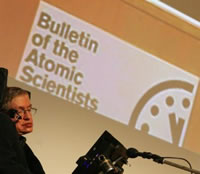Published online: 17 January 2007; | doi:10.1038/news070115-8
Doomsday draws two minutes closerAtomic scientists add climate change to the threats to humanity.Geoff Brumfiel 

| Steven Hawking and other physicists remind the world of the perils of nuclear weapons - and of climate change too.
Lewis Whyld/PA Wire |
|
The
Bulletin of Atomic Scientists has moved the hands of its Doomsday Clock
to five minutes before midnight — the metaphorical marker of the end of
humanity.
Two
factors prompted the Bulletin's board to move the clock forward by two
minutes: the spread of nuclear weapons and, in a first for the group,
climate change. "The unthinkable seems closer now, in some ways, than
it ever was," says Lawrence Krauss, a physicist at Case Western Reserve
University in Cleveland, Ohio, and a member of the Bulletin's board.
Several prominent scientists made the announcement at a press conference held jointly in Washington and London.
The
chief reason for the move is the dawn of a "second nuclear age", in
which far more countries can acquire nuclear technology. The Bulletin
cited North Korea's October test of a nuclear device, the nuclear
smuggling network of Pakistani scientist A. Q. Khan, and the diplomatic
failure to halt Iran's nuclear programme as examples of the growing
threat from proliferation.
It
also pointed to the nuclear stockpiles of the United States and Russia,
which together possess around 26,000 warheads. Although the threat of
global nuclear annihilation has declined, the threat of a regional war
that could kill millions has grown, says Martin Rees, an astronomer at
Cambridge University, UK: "There is now more chance than ever of a few
nuclear weapons going off in a localized conflict."
Branching out
The
Bulletin's second concern, climate change, represents a new direction
for the organization, which a group of Manhattan Project scientists
started in 1945 to warn of the threat of nuclear annihilation. "When we
looked at doomsday, we realized that there were other technologies and
trends that we needed to include," says Kennette Benedict, the
Bulletin's executive director.
After
considering several threats, including nanotechnology and bioterrorism,
the group decided that the dangers of climate change are almost as dire
as those of nuclear weapons.
The Doomsday Clock was unveiled in 1947, set at seven
minutes to midnight. Its hands have been moved forward or back 17 times
before the latest announcement. It came closest to midnight, within
just two minutes, in 1953, when the United States and the Soviet Union
tested hydrogen bombs within nine months of each other. "The world has
come to the brink of disaster on more than one occasion," says
cosmologist Stephen Hawking. "But for good luck, we would all be dead."
The
last adjustment was in 2002, when the clock was moved forward two
minutes in response to the 2001 terrorist attacks on the United States
and the Bush administration's nuclear policies, such as its withdrawal
from the anti-ballistic missile treaty.
The
decision to move the clock is no surprise, says Daryl Kimball,
executive director of the Arms Control Association, a non-profit think
tank in Washington DC: "2006 was clearly one of the worst years in
terms of trying to stop the spread of the bomb."
Visit our newsblog to read and post comments about this story.
|

